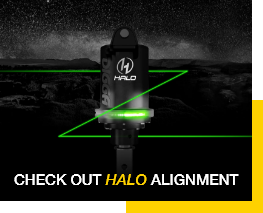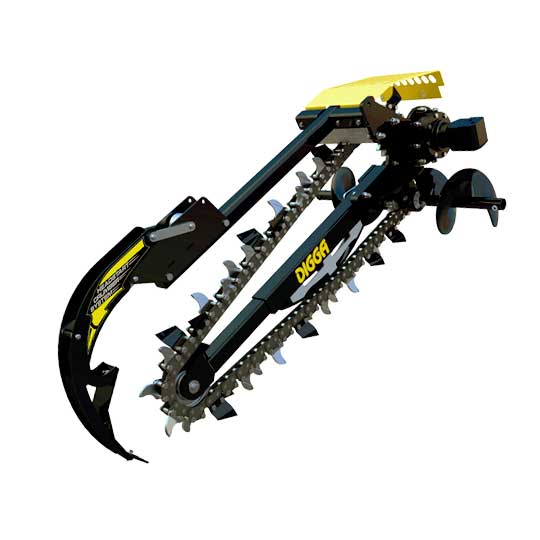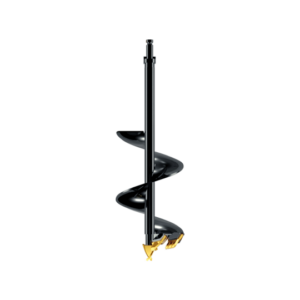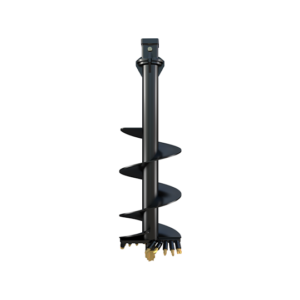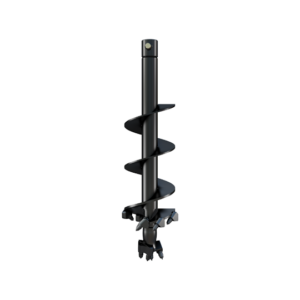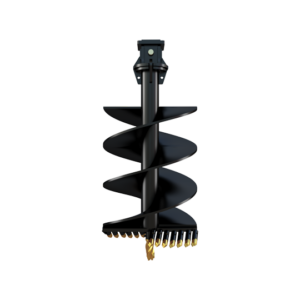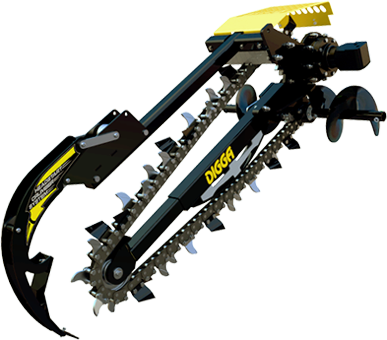
1200 Hydrive Trencher
1200 Hydrive Trencher

Work smarter, not harder
Digga’s Hydrive range is engineered for heavy-duty trenching on excavators, skid steer and tracked loaders up to 8 tonnes, with standard models offering up to 1200mm digging depth. For larger machines up to 8 tonnes, the XD models deliver wider cutting widths and increased power—perfect for irrigation, underground utilities, road repairs, and construction projects. With advanced features and robust design, the Hydrive trencher excels across all trenching applications.
Equipped with a unique drive system for optimal horsepower, a heavy-duty crumbing system, and twin spoil augers for a cleaner finish, the Hydrive ensures precision and performance. Its high-visibility grille improves operator safety and speed, while the anti-back flex chain and versatile tooth configurations allow trenching in all ground conditions—from soft soil to permafrost. Built to last, the Hydrive trencher is your go-to solution for tough jobs.
Ground Conditions
Machine Suitability
Chains Available
Warranty
Dig into:
Specifications
Dig into:
Operator’s Manuals
Dig into:
About Trenchers
Dig into:
FAQs
Features
Faster and more efficient. A trencher will cut ground faster than an excavator bucket, as it cuts with continuous movement.
Easier. The spoil is excavated more finely with a trencher, so the trench can easily be backfilled with better compaction. Finer spoil makes it suitable for the bedding of pipes and cables.
Accurate. Only excavate what is required, with various size trenching widths, and a flatter/cleaner trench bottom.
Cost effective. Digs faster than an excavator or backhoe, with less mess. Spoil is easier to backfill with better soil compaction.
Specifications
Digga’s Hydrive Trenchers are built for efficiency and precision in tasks like irrigation, utilities, road repairs, and construction. Suitable for skid steer loaders up to 8 tonnes, with XD models for machines up to 8 tonnes, they feature twin spoil augers, an anti-back flex chain, and a heavy-duty crumbing system for cleaner, faster trenching. Contact our team for quotes, orders, or expert advice to find the perfect trencher for your needs.
| Machine Size Suitability | Up to 4.5T |
| Chain Options | Earth / Combination / Diggatac |
| Chain Cutting Width | 100mm / 150mm / 200mm / 250mm / 300mm |
| Foot Depth Presets | N/A |
| Hydraulic Flow | 50lpm - 80lpm |
| Maximum Pressure | 240bar at 60lpm |
| Maximum Flow | 75lpm at 200bar |
| Maximum Continuous Power | 25Kw (34hp) |
| Overall Length | 2160mm |
| Horizontal Height | 802mm |
| Width | 1212mm |
Heavy Duty Crumber Bar
Head-start Crumber System
Twin Spoil Augers
High Visibility Grille
Heavy Duty Scraper Shoe
Anti-back-flex Chain Design
Raised Motor
Earth Teeth
An EARTH tooth configuration is best suited for soft clean ground with no floaters or tree roots like earth and clay.
Combination Teeth (Combo)
Get the best from both worlds with a multipurpose chain configuration. A COMBINATION of earth and tungsten carbide teeth. Cut through hard soil, roots, soft shale, and rocky ground.
Diggatac Teeth
The DIGGATAC tungsten carbide chain configuration provides extended tooth life and reduced vibration, particularly when starting in tough conditions such as rocky hard shale, asphalt or frozen ground.
| Earth | Combination (Combo) | Diggatac | |
|---|---|---|---|
| Cutting Width | 100mm to 350mm | 100mm to 300mm | 100mm to 300mm |
| Trencher Suitability | All | All | All |
| Soft Ground: General Soil, Sandy Loam, Soft or Wet Clay | Yes | Yes | Yes |
| Medium Ground: Compacted Soil, Fracturable Shale, Fracturable Rocky Ground | - | Yes | Yes |
| Hard Ground: Dry Compacted Clay, Dry Compacted Soil, Hard Shale | - | - | Yes |
| Extreme Conditions: Solid Rock, Asphalt, Frozen Ground, Highly Abrasive Ground | - | - | Yes |
| Hydrive 900 | Hydrive 1200 | Hydrive XD 1200 | |
|---|---|---|---|
| Mini Machines (750kg to 1.5T) | - | - | - |
| Tractors | Yes | - | - |
| Mini Excavators | Yes | yes | - |
| Skid Steer Loaders | Yes | Yes | Yes |
| Skid Steer Loaders (High Flow) | - | - | - |
| Backhoes | - | - | Yes |
| Excavators (4.5T to 8T) | - | - | Yes |
MY.DIGGA.COM
Find everything you need for your Digga attachment - Including operator manuals, safety information, risk assessments, electrical guides, maintenance tips, and 'how to' instructions. Our user-friendly interface and easy navigation ensure that you can quickly access the support and information you need.
LEARN MORE ABOUT TRENCHERS
From understanding the different types of trenchers available, to learning about components and maintenance. We hope you find this information helpful.
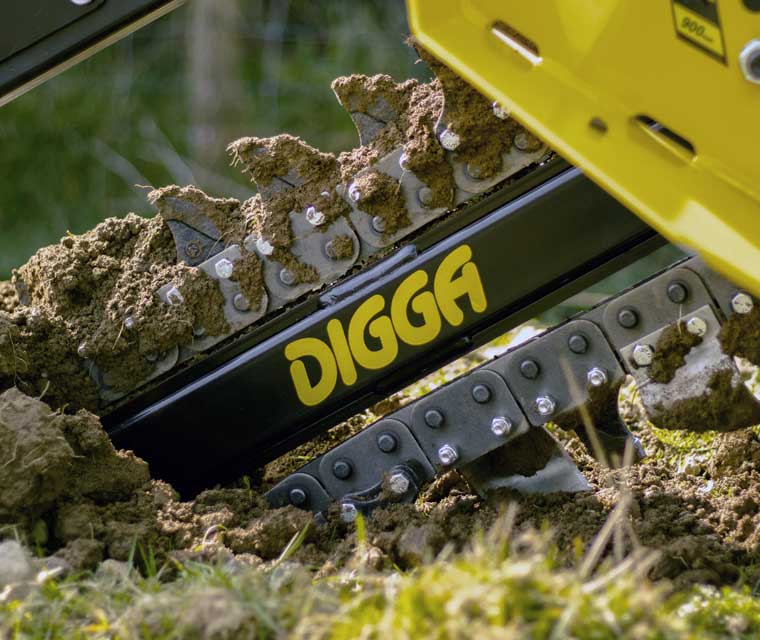
FREQUENTLY ASKED QUESTIONS [FAQS]
Why would I use a trencher instead of an excavator bucket?
There are a couple of advantages of using a trencher over an excavator bucket:
- When a narrow trench is required 100mm, 150mm, 200mm, you can get a deeper trench, up to 1500mm by using a trencher over an excavator trenching bucket.
- Quite often the spoil that is removed with an excavator trenching bucket is lumpy and unusable for backfill material and as such is needed to be taken away to landfill and soil is then purchased to backfill the trench. With a trencher the spoil that is removed from the trench is deposited next to the cut trench and is in such a form that it can be then re-used to backfill the same trench.
Which trencher best suits my host machine?
This would all depend on what your application requires, i.e. depth of trench, width of trench, expected ground conditions, and what are the hydraulic capabilities of your host machine.
Once our experienced staff have these details, we will be able to offer the various options to you.
What’s the difference between a Bigfoot and a Bigfoot XD trencher?
The first noticeable difference is in the chain size. The Big Foot Trencher (BFT) uses a 1.654” Pitch Chain, whereas the Big Foot XD (BFT2) uses a 2” Pitch Chain. The 2” chain and teeth being larger and are more extreme heavy duty.
The BFT has a maximum chain/trench width of 200mm. The BFT2 has a maximum chain/trench width of 300mm. Given that the BFT2 has larger chain and width capabilities, the power/torque of the BFT2 is increased by 20% over the BFT.
Please refer to our product brochures to determine which model is best suited to your application and host machine.
How deep will my trencher dig?
Our BFT & BFT2 Trenchers have been designed to give you controlled depth options:
- Mini BFT - 450/600/750/900mm.
- BFT (900) - 600/750/900mm.
- BFT XD (900) – 450/600/750/900mm.
- BFT XD (1200) – 600/800/1000/1200mm.
- BFT XD (1500) – 750/1000/1250/1500mm.
The Hydrive and Hydrive XD depth ranges from 0 – 1200mm, all governed/guided by the operator’s experience.
Can I replace the chain with a bigger or smaller chain (width)?
Yes, quite simply by loosening off the chain then locating and removing the joiner pin/link. Roll off the chain complete and replace with your smaller or larger width chain as required. Bring the ends of the chain together and replace the joiner pin/link. Retention the chain to the recommended tension as per operator manual guidelines.
Can I change the chain from Earth to Diggatac (earth to rock)?
Yes, you could manually remove every earth tooth, nut, bolt and spacer of your earth chain and replace these with a complete set of Diggatac teeth, nuts, bolts and spacers to reconfigure to a Diggatac Chain. BUT, given the time and effort required to do this it is far more economically viable to have a second complete chain which can be removed and replaced in a fraction of the time.
Can I buy spare parts for my trencher?
Yes, all Digga Trenchers are manufactured in our company owned facilities, guaranteeing spare parts are readily accessible.
Will the trencher cut through tree roots?
Bear in mind the trencher is not a chain saw, but it will cut through the odd tree root. It will also cut through water, power, phone and data cables, so always consult your local services locator before commencing any trenching work.
Do I run the trencher forward or backwards
When mounted to a SSL or CTL the operator must always operate the trencher in a reverse direction. That is with the top of the chain moving away from the operator and the bottom of the chain coming back towards the operator as it cuts through the soil always while moving the host machine in a slow, controlled reverse direction.
When do I need a Crumber Bar?
Crumber Bars or Scraper Bars are designed to scrape the bottom of the trench behind the chain as the trencher moves/cuts through the soil leaving a smooth flat spoil free trench.
In some cases, such as the laying of irrigation pipes, the installer may require a soft bed of loose soil for the pipe to lay on. This can be achieved by simply folding back the Crumber/Scraper Bar for this application.
NOTE: The danger bar that the Scraper/Crumber Bar is fixed to must NEVER be removed.
Does my tractor or telehandler require a hydrostatic or Vario transmission?
If you wish to mount a trencher on your tractor, telehandler or loader, etc., they MUST always have HYDROSTATIC transmission. There are no tractors, telehandlers or loaders with conventional mechanical gearboxes that can travel slow enough for the effective operation of a trencher attachment. In hard ground conditions you may find the need to be travelling at a rate as slow as 0.075 Klm/h.
What is a hydrostatic drive?
A hydrostatic drive is a type of transmission system that typically uses fluid power, specifically hydraulic fluid, to transfer energy from a pump to a motor, enabling movement in machinery. It is commonly used in equipment like excavators, tractors, skid steers, and Mini loaders, due to its smooth and precise control over speed and torque. a hydrostatic drive is a fluid-based transmission system that excels in providing precise control, durability, and high torque.
What maintenance is required for the trencher?
Mostly all Digga trenchers have a Digga Planetary Gearbox fitted and do require the periodic oil change as most mechanical devises do. Consult your operator manual for direction.
Besides gearbox maintenance it is best practise to periodically check the tension of your chain and of the chain tooth wear. The teeth of the trencher are a wearpart and as such may require replacement. Your operator manual has a guide on the loss of efficiency of the chain’s performance relevant to the tooth wear.
Does the trencher chain self-tension if it comes loose?
No, the trencher chain will require the operator to physically tension the chain as required. All tooling for this is supplied on the trencher and only takes a few minutes to complete. Your operator manual has a guide on best practise for correct chain tension.
